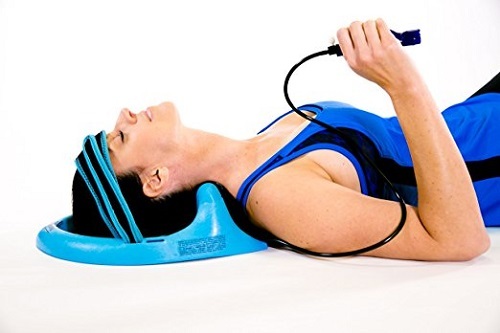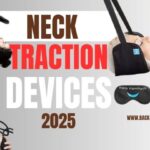As you probably know, both the posture pump and the inversion table are designed to decompress your spine, including your cervical spine.
However:
They differ in the way they get it done.
What’s better for neck pain, Sciatica, or a herniated disc: Posture Pump or inversion table?
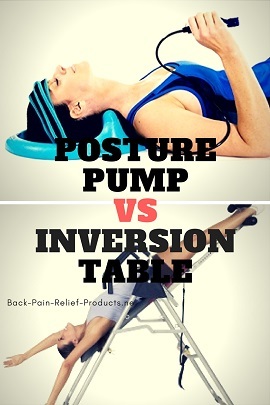
In this post, you’ll find all the differences between the posture pump and the inversion table, to help you decide which device is better to decompress your spine.
This post contains affiliate links, at no extra cost to you.
Overview
Posture Pump vs. Inversion Table – How do They Work?
First, let’s see what a posture pump is, and what an inversion table is:
What is a Posture Pump?
Posture pumps are designed to decompress, “shape” your spine, and rehydrate your spinal disks. Traction is done while lying down, using a manual hand pump.
Why do you need to rehydrate your spinal disks?
Because when (with age or due to injury) the neck and back lose their natural curved shape, the soft discs between the vertebrae get compressed, and the rich lubricating fluid is unable to penetrate and hydrate the discs.
The result:
Premature aging, stiff, dry joints, and pain.
There are 3 types of posture pumps:
1. The cervical posture pump (for neck pain)
2. The Lower Back Posture Pump (for lumbar pain)
3. The full spine posture pump (back and neck)
The original posture pump was created by a doctor with a 25-years of experience in treating low back pain and neck pain.
How Do You Use the Posture Pump and How Does It Decompress Your Spine?

You simply lie down, make sure that you are centered over the middle of the pad, and that your neck/low back are aligned straight over the pad.
Then you place the chin strap in place and use the hand pump to pump the bladder as much as you can tolerate.
Then you pause for 5-10 seconds and release the pressure.
Do not do more than 25 repetitions, and it’s best to consult with your doctor about how many repetitions you need.
This is when the spine decompression magic happens:
When the disks are pulled slightly away from each other, the muscles, ligaments, bones, and nerves can heal and function better, thus eliminating your pain.
What is an Inversion Table?
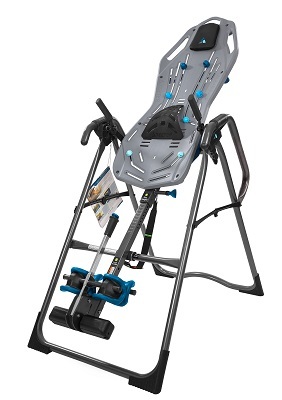
Inversion tables use gravity to decompress your spine.
An inversion table is a board that is placed on an elevated axis so it can rotate. Your ankles strap into it, and you slowly turn upside down.
This allows gravity to decompress your spine and hip joints as the angle increases.
The best inversion tables are designed with high-quality metal elements and safety-enhancing features such as auto-locking safety hinges, sturdy pivot bearings, and cam locks.
And now, here are the major differences between the posture pump and the inversion table:
Inversion Table vs. Posture Pump for Back & Neck Decompression
Here are the most important differences to help you make the best choice for your needs:
1. Size
Obviously, the inversion table is a much bigger device than the posture pump and requires more space for storage.
The inversion table’s average size is about 48.5 x 30 x 8.9 inches, and it weighs about 60 pounds.
The cervical posture pump is 14.5 x 13.3 x 4.5 inches and weighs only 2 pounds.
However, most inversion tables can be folded and stored under your bed.
2. Weight and Height Limitations
The posture pump fits all people, no matter their weight and height.
Inversion tables usually support users between 4’8″-6’6″ and up to 300 lbs., except for the Ironman 4000 inversion table, which supports 350 pounds.
3. Assembly
The posture pump comes fully assembled.
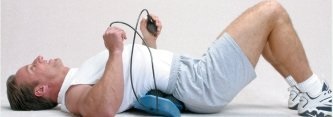
Inversion tables require some assembly, which usually takes no more than 30 minutes.
4. Safety
The inversion table uses hanging upside-down to decompress your spine, while the posture pump is used while lying down.
While the best inversion tables are made with high-quality materials and ensure that you are well strapped to them, the posture pump does not require hanging upside down for back traction.
Inversion tables are not recommended for people with eye pressure conditions, inner ear pressure, hypertension (unbalanced), bone fractures, implanted spine hardware, or pregnancy.
Here’s a screenshot from the Teeter Hangups website, with the full list of contraindications:

The posture pump is safer for people with eye and ear conditions.
However, it is not recommended for people with fractures, spinal cord compression, implanted spinal hardware, spinal surgery, or inflammatory disease.
Here’s the full list of Posture Pump contraindications:

To sum it up:
Both devices have a few contraindications, but posture pumps are safer for people with eye pressure and inner ear pressure conditions.
In any case, it is highly recommended to consult with your doctor before using any of them.
5. Effectiveness
Both devices are similarly effective. However, inversion therapy is less powerful for neck traction at home.
For neck decompression, the cervical posture pump would be more effective, especially the Cervical Posture Pump.
6. How Long Before You Feel Results?
As you know, everyone is different. Some people feel immediate relief and a decrease in symptoms right away.
Others, depending on symptoms and issues, may take longer and have gradual relief of symptoms over time.
This is true for both devices.
See Our Full Review for the Posture Pump
7. Treatment Time
Inversion tables can be used for 5-20 minutes, 3-7 days a week.
Posture pump treatment time is up to 15 minutes, 3-5 times a week, daily.
8. Ease of Use
Through my research, the posture pump is somewhat easier to use.
9. Studies
Both the gravity table and the posture pump are proven to relieve back and neck pain through spinal decompression.
For example, this study about inversion therapy has found:
Our results demonstrated a significant increase of forward trunk flexion, a general reduction of paraspinal EMG activity, a significant level of distraction of the L4-5 and L5-S1 disc spaces, as well as a lack of change in heart rate and blood pressure
And this study about the Posture Pump has found:
On the initial pre/post MRI’s and single 20-minute treatment, the following changes were noted in 34 patients:
1 or more decreased disc bulges— 20 patients
Disc lightening (possibly due to increased disc hydration) – 16 patients
Decreased disc bulges with spinal cord indentation – 7 patients
Increased lordotic curve – 6 patients
Stress vertebrae alignment changes- 3 patients
Changes in stair-stepping of vertebrae- 2 patients
No visible MRI change – 2 patients
Bottom Line
Medical equipment such as the Posture Pump and inversion tables is designed to decompress the spine.
Both devices primarily focus on the hydration of the disk and the ability of gravity to restore the disk’s hydration.
With proper hydration of the disk, the muscles, ligaments, bones, and nerves of the spine can function better and with little compromise.
The Posture Pump is a better choice for people who mostly want to decompress the cervical area or are hesitant to hang upside down while using an inversion table.
Inversion tables are a better choice for people suffering from lower back pain issues, including bulging/herniated discs.
Now that you know most aspects of the inversion table VS the posture pump, you may feel more confident when choosing the best method for your needs.
To your health and happiness,
The Back Pain Relief Products Team
